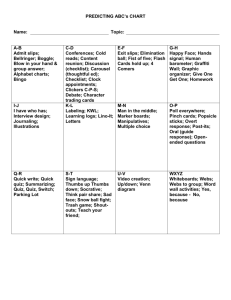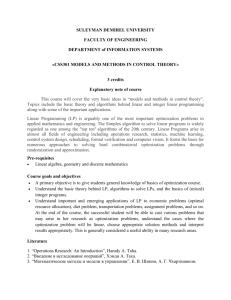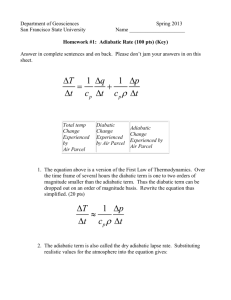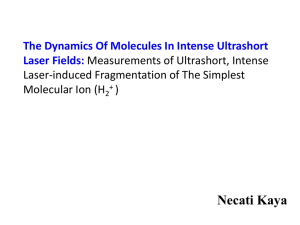PowerPoint format - Chemical Theory Center
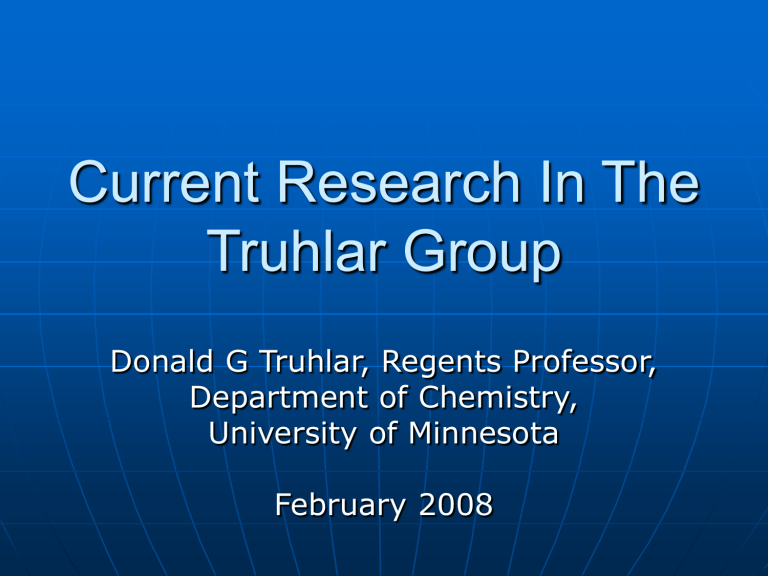
Current Research In The
Truhlar Group
Donald G Truhlar, Regents Professor,
Department of Chemistry,
University of Minnesota
February 2008
Research Activities And
Group Members
Kinetics and potential surfaces for reactions in gases, liquids, and enzymes
(Luke Fiedler, Ewa Papajak, Masahiro Higashi and Jinjing Zheng)
Photochemistry, Non-Born-Oppenheimer potentials, and diabatic couplings
(David Bonhommeau, Oksana Tishchenko and Rosendo Valero)
Density Functional Theory (Yan Zhao)
Nanocatalysis (Bo Wang)
Solvation and Electrochemistry (Adam Chamberlin and Aleksandr Marenich, collaboration with Christopher J Cramer)
Potential surfaces for geochemistry and atmospheric chemistry (Hannah
Leverentz and Meiyu Zhao, collaboration with Profs. Renata Wentzcovitch and
Ilja Siepmann)
Polarizable potentials (Wangshen Xie, collaboration with Prof. Jiali Gao)
Zinc enzymes and nanozinc (collaboration with Anastassia Sorkin and Prof.
Elizabeth Amin)
Bionanorings (Brian White, collaboration with Profs. Carston Wagner and
Elizabeth Amin)
Kinetics And Potential Surfaces
For Reactions in Gases, Liquids,
And Enzymes
Applications of MCMM and QM/MM techniques to condensed-phase chemical reactions (M. Higashi)
Applications of Transition State Theory to barrierless reactions (J. Zheng)
Study of haloalkane dehalogenase halide displacement reactions (R. Valero)
Toward Accurate Calculation in Condensed-Phase Chemical Reaction:
Electrostatically Embedded Multiconfiguration Molecular Mechanics
Based on the Combined Quantum Mechanical and Molecular Mechanical Method
Combined quantum mechanical and molecular mechanical (QM/MM) methods have provided powerful means for studying chemical reactions in the condensed phase such as solutions, enzymes, and solids. In these approaches, the reaction center is described quantum mechanically, while the surroundings are treated by using a molecular mechanics force field. However, the high computational cost of quantum mechanical (QM) calculations prevents one from carrying out QM/MM molecular dynamics simulations with reliable accuracy and adequate sampling.
In order to reduce the computational cost of the QM calculation, we developed a new method called Electrostatically Embedded MultiConfiguration Molecular
Mechanics (EE-MCMM) for generating global potential-energy surfaces (PESs) in the presence of an electrostatic potential. The global PESs of condensed-phase reactions can be determined by electronic structure calculations performed at some selected gas phase geometries. Due to the efficiency of this new method, high-level QM calculations can be applied to QM/MM methods.
The result is a key step toward studying chemical reactions in condensed phase with high-level QM calculations.
Cl + CH
3
Cl’ → ClCH
3
+ Cl’ in aqueous solution
Equipotential contour plots of the PES calculated by the EE-MCMM method.
Equipotential contours plots of the difference methods.
between the PESs calculated by the EE-MCMM and direct
Implementation and Application of Transition State Theory for Barrierless Association Reactions
The absence of a barrier in association reactions challenges theoretical chemists to understand the mechanism of reactions that occur in a wide variety of chemical environments, e.g., combustion chemistry, atmospheric chemistry, and interstellar chemistry.
A + B AB
R(A-B)
● Computer program development:
Implementing variable-reaction-coordinate transition state theory into the
POLYRATE program to determine barrierless association reaction rates.
Implementing master equations into the POLYRATE program to determine pressure-dependent rates and multi-well reactions.
● Applications:
Mechanism of radical-radical and radical-molecule association reactions in combustion chemistry and atmospheric chemistry.
Acetate ion + 1,2-dichloroethane (DCE): A Model Reaction For
Haloalkane Dehalogenase Halide Displacement Reaction
● First goal: construct valence-bond-like diabatic electronic states for acetate + DCE reaction.
Two different strategies
Fourfold way:
* Starts from ground and first singlet excited adiabatic states.
* Constructs two VB-like diabatic configurations by using localized reference MOs.
Molecular orbital valence bond (MOVB):
* Constructs localized MOs in the fragments VB resonance forms.
* Each VB resonance form is a diabatic state.
* Adiabatic energies from diagonalization of Ĥ with VB forms.
● Final goal: use diabatic states in haloalkane dehalogenase QM/MM dynamics.
Adiabatic and diabatic energy profiles for the acetate + DCE reaction
-
O
O
· · Cl
R
Cl
Reactant complex
Fourfold way diabatic states
O
O
· · Cl -
Cl
P
Product complex
MOVB* diabatic states
*Collaboration with
Lingchun Song and
Prof. Jiali Gao
Photochemistry,
Non-Born-Oppenheimer Potentials,
And Diabatic Couplings
Zero-point energy effects in the photodissociation of ammonia (D. Bonhommeau)
Spin-orbit effets in the photodissociation of HBr (R. Valero)
Zero-point energy (ZPE) effects in the photodissociation of ammonia
● NH
3
, a model system:
To study the dynamics close to a conical intersection.
With a potential-energy barrier (indirect photodissociation).
With 6 vibrational modes (3 stretches, 2 bends, and 1 inversion mode―also called the “umbrella” mode) in the well of its first excited electronic state.
● Several mixed quantum-classical (or semiclassical) methods are available:
An improved mean-field approach, the CSDM (Coherent Switching with Decay of
Mixing) method, in which the dynamics is performed on an average potentialenergy surface (in diabatic or adiabatic representation).
An improved trajectory surface-hopping method, the FSTU (Fewest Switches with Time Uncertainty) method, in which the system is propagated on a single diabatic or adiabatic surface, and hops can occur between surfaces to take into account the existence of several surfaces.
Semiclassical dynamics after exciting the umbrella mode
2
(n
2
)
Dynamics
Results using the
CSDM method
Excitation n
2
= 0,…,6
● NH
3
, a model system:
Qualitative agreement with experiment.
But the NH
2 internal energy can be negative with respect to the ZPE which is unphysical.
● Correcting the loss of ZPE by:
Performing an instantaneous normal mode analysis and modifying liear momenta during the dynamics when the NH
3
ZPE is below the NH
ZPE (0.519 eV in the ground electronic state).
2
Keeping the dynamical method unchanged whether the ZPE is above the NH
2
ZPE.
Comparison to experiments for n =0
Experiment
Theory
2
Spin-orbit Branching Fraction in Photodissociation of HBr by Mixed Quantum-Classical Dynamical Methods
● Step 1: spin-free curves diabatic spin-coupled curves adiabatic spincoupled curves.
● Step 2: compute nonadiabatic cross sections from ground-state Franck-
Condon sampling + quantum-classical dynamics.
(
)
3
0
(
)
3
1
(
)
Total
(
)
Branching fraction calculated with CSDM quantum-classical trajectory method agrees well with experiment
Density Functional Theory
Application of new Density Functionals to a broad range of chemical processes (Y. Zhao)
Application Of New Density Functionals
To A Broad Range Of Chemical Processes
● Shortcomings of some popular DFT methods (e.g., B3LYP):
Better for main-group chemistry than for transition metals.
Systematically underestimate reaction barrier heights.
Inaccurate for interactions dominated by medium-range correlation energy, such as van der Waals attraction, aromatic–aromatic stacking, and alkane isomerization energies.
● New set of DFT functionals, the M05 and M06-class functionals:
M06-2X and M05-2X functionals for main-group thermochemistry and kinetics.
M06-2X, M05-2X, and M06 for systems where main-group thermochemistry, kinetics, and noncovalent interactions are all important.
M06-L and M06 for transition metal thermochemistry.
M06 for problems involving multireference rearrangements or reactions where both organic and transition-metal bonds are formed or broken.
M06-2X, M05-2X, M06-HF, M06, and M06-L for the study of noncovalent interactions.
M06-HF when the use of full Hartree-Fock exchange is important, for example to avoid the error of self-interaction at long-range.
M06-L when a local functional is required, because a local functional has much lower cost for large systems.
Solvation And Electrochemistry
Applications of SM8, a new solvation model (A. Marenich)
Applications of SM8 with Temperature, SM8T (A. Chamberlin)
Solvation Model 8 (SM8)
● Principle of SM8:
Simplification of the Schrödinger equation for a liquid-phase system (solvent = dielectric continuum with some dielectric constant , solute = system of atomic cavities and charges)
The bulk-electrostatic contribution to the free energy of solvation calculated quantum-mechanically by a self-consistent reaction field procedure using the generalized Born equation or the Poisson equation for electrostatics.
SM8 accounts for contributions beyond the bulk electrostatics (for instance, dispersion, hydrogen-bonding interactions, etc.) by means of a special parametrization of such contributions.
General Theory Underlying To SM8
SM8 calculates aqueous solvation free energies based on gas- or liquid-phase optimized geometries.
G
S
G
ENP
G
CDS
Electronic-
Nuclear
Polarization
Cavitation,
Dispersion,
Solvent Structure
Change in the solute free energy due to electrostatic interactions between the solute and the bulk solvent and distortion of the solute’s electronic structure in solution.
The solvent is modeled as a dielectric continuum.
Non-bulk electrostatic contributions to the free energy of hydration: first solvation shell effects.
The G
CDS term is a parameterized term intended to minimize the deviation between the predictions and experiment.
It involves atomic surface tensions.
Simulations With SM8
● SM8 successes:
SM8 is implemented in Gaussian 03, GAMESS, Jaguar, and NWChem.
SM8 covers several databases for aqueous neutrals, nonaqueous neutrals, aqueous ions and nonaqueous ions.
Mean Unsigned Errors (MUE) are very small, that is SM8 predicts energies close to available experimental data.
Solvation Model 8 With Temperature (SM8T)
Benzene in water
G
CDS
:
G
CDS
G
CDS
G
CDS
( T )
Non-electrostatic contributions to the free energy of solvation at the reference temperature at T
0
(298 K).
Temperature dependence of the non-electrostatic contributions to the free energy of solvation relative to 298 K.
● Variation of G
ENP
( T ) and G
CDS
(T) from 273 to 373 K: the case of benzene.
2
1.5
1
0.5
0
-0.5
-1
-1.5
-2
( ) Experimental free energy of hydration
( ) Δ G
ENP
( T ) component
( ---) G
CDS
(T) component
280 300 320
Temperature (K)
340 360
G
ENP
(T) variations are limited to 0.01 kcal/mol for benzene in water.
G
ENP
(T) variations increase to 0.24 kcal/mol for benzene in octanol!
Some Solutes Included In SM8T Databases
0.16
0.14
0.12
0.10
0.08
0.06
0.04
0.02
0.00
C,H containing compounds
Alcohols,
Phenols, and
Water
Aldehydes Ketones
Class of Solute
Ethers Esters Carboxylic
Acids
( ) Individual fits
( ) van’t Hoff
( ) Unrestricted - 14 parameters
( ) Final - 7 parameters
Individual Fits: Fits to the experimental data for each compound using the thermodynamic equation
Some Biological Applications of SM8 and SM8T
● Interesting challenge:
Mixed Solvent.
Solvent varies from sample to sample.
Solvent properties vary from sample to sample.
● Important pharmacologic applications:
Brain-Air partition coefficients correlate well with oil/air partition coefficients.
Biological uptake correlates well with oil/water partition coefficients.
Reduced use of laboratory test subjects.
Faster drug development.
Further information http://comp.chem.umn.edu/truhlar

